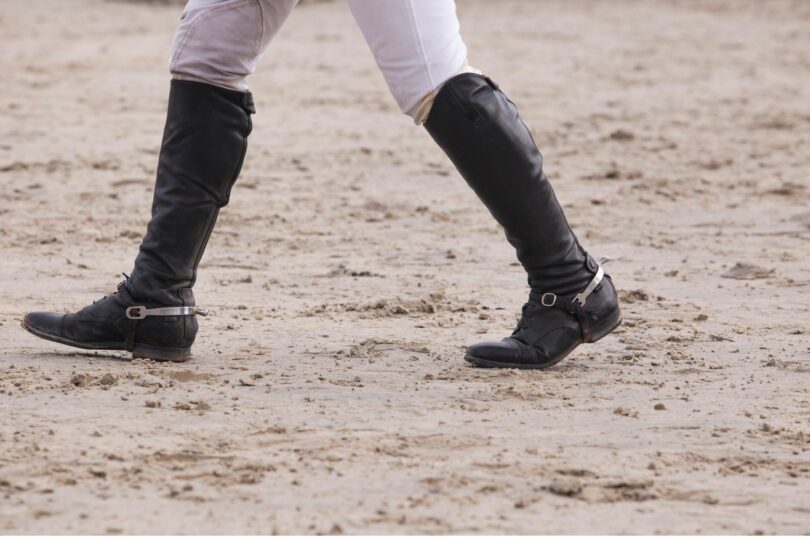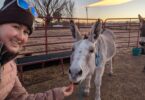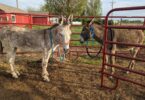Stay the course!
Congratulations—you’re going to your first competition where you will be jumping a course. This is an exciting and monumental moment in your riding journey. Regardless of whether you are entering the short stirrup hunter ring or the “green as grass” eventing division, a course walk will be an important part of your show day.
When you understand the importance and mechanics of a course walk, you will be able to transfer the knowledge you learned on the ground to a confident ride in the saddle.
Course Walking Basics
Walking a course is different from schooling a course in the saddle. It requires focus and a keen eye in addition to understanding the track of your class’s course.
You will notice things on the ground that you won’t notice in the saddle.
This is important, because it may be something your horse could see that you wouldn’t be aware of otherwise. A spooky banner at the end of the arena? That may be something you miss in the saddle!
What is a course walk?
A course walk generally occurs before any of the jumping classes begin at a show, and after a course is set. Course walks are found in
During a set time, which will be stated in the prize list, riders and their trainers are invited into the arena to walk the track that they will ride in their class and come up with a plan to execute the best ride possible.
Why do riders walk the course?
Walking a course is important to the rider to understand how a course is going to ride.
By understanding the distances between jumps, you will know if the course designer set a jump distance a little short (requiring you to shorten your horse’s canter stride) or a little long. If it is a little long, it would require you to either add a stride or ask your horse for a more forward canter to prevent your horse from leaving long.
It also allows a rider and trainer to discuss the best places to make turns and shave off seconds in a speed round.
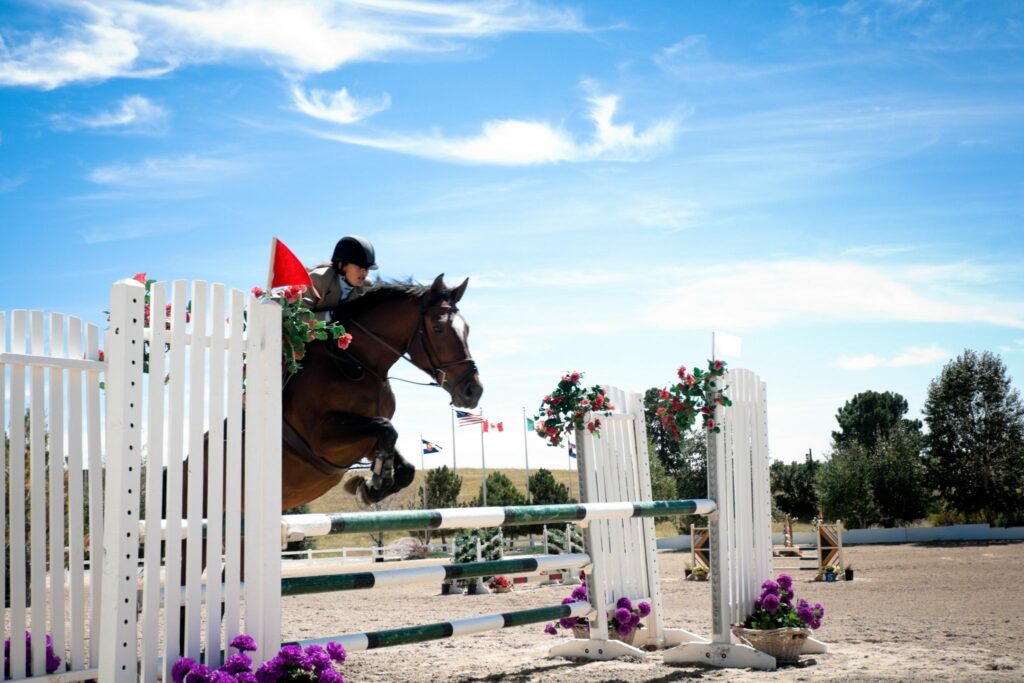
Photo Cred: Canva
Course Walk Etiquette
Riders usually congregate around the in-gate just prior to a course walk. Ideally, those at the top of the start order can get the walk done nice and early. They will make their way to the front of the pack, since they need to get to the warm up area and prepare for their ride.
It is important to wait for the in-gate steward or the announcer to invite you into the arena and to wait for the water truck and the drag tractor to exit before entering the arena.
Tip: Do not be late to the course walk!
Trainers often walk the course with large groups of students following them. When possible, it is nice to allow them to travel through the walk together so that they can gather to discuss their plan.
If you pause along your walk, step aside to allow others to walk from the base of one jump directly to the base of the next.
Analyzing the Environment
The course walk will often be your last opportunity to make observations about the competition environment before you show. You will likely be able to gather more information about what the light will be like at your ride time.
For example, if your class is later in the day, a particular jump could have a dark shadow on or near it that could cause a spook and require a more confident ride.
As your competition time nears, you will have a better sense of the weather and how rain, wind or extreme heat may have changed the footing or the competition environment.
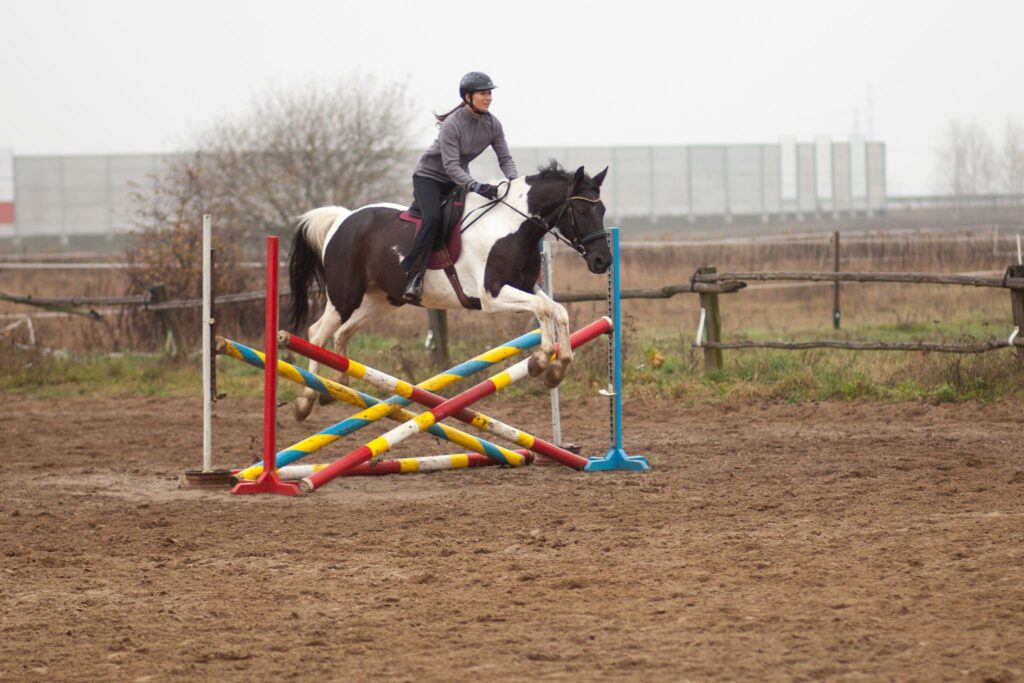
Source: Canva
If the weather becomes too extreme, horse show management may postpone the rest of the show. Listen for updates as your ride time approaches.
Slip is a natural part of jumping and of most footing. In the most natural of footing (i.e., sand and grass), the horse slips into the ground a little on both takeoff and landing.
If the weather conditions make it likely that the horse will slip into the footing too much, horse shoe studs can be used to help reduce slipping. Studs should be just big enough to prevent excessive slipping without causing the horse’s hooves to get stuck in the ground. Studs are meant to be used in natural sand footing and on grass.
Remember: A little bit of slip is okay.
Most modern footing can handle a lot of water and is safe to compete on. The majority of synthetic footing functions well without studs. This “no-slip” characteristic is generally considered advantageous, but be careful if a horse is not accustomed to synthetic footing.
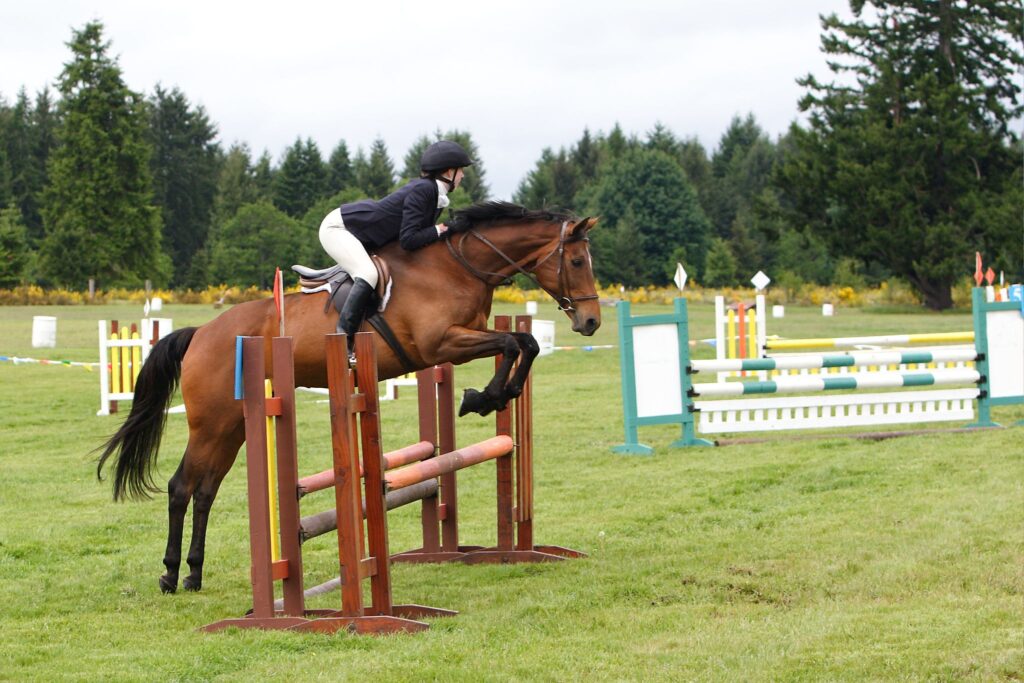
Source: Canva
Occasionally, the increased stickiness can cause a horse to trip on landing or to feel a little “stuck” at a wrong distance.
It is the responsibility of the rider to understand how to balance on the turns within the given conditions.
Path and Pace
Along with a variety of obstacles and visual styles, the course designer will incorporate different types of lines between jumps.
Beginner-level competitions only include straight lines and single jumps. Upper-level competition includes bending lines, straight lines, differing related distances, rollbacks, blind turns, combinations and a mix of long and short approaches.
Mid-level competitions should begin to introduce all of the elements of upper-level classes in an inviting and educational way.
Straight lines can vary greatly in difficulty. Here are example questions to consider:
- Is the line from a vertical to an oxer?
- An oxer to a vertical?
- Are the jumps off a short turn or a longer approach?
- Does the distance in between the jumps correlate to a comfortable stride?
- Do you need to make a decision about shortening or lengthening?
The course designer will present a variety of questions in each course and they will increase in difficulty as the levels go up. As the fences get larger, the technicality of the courses increases, too.
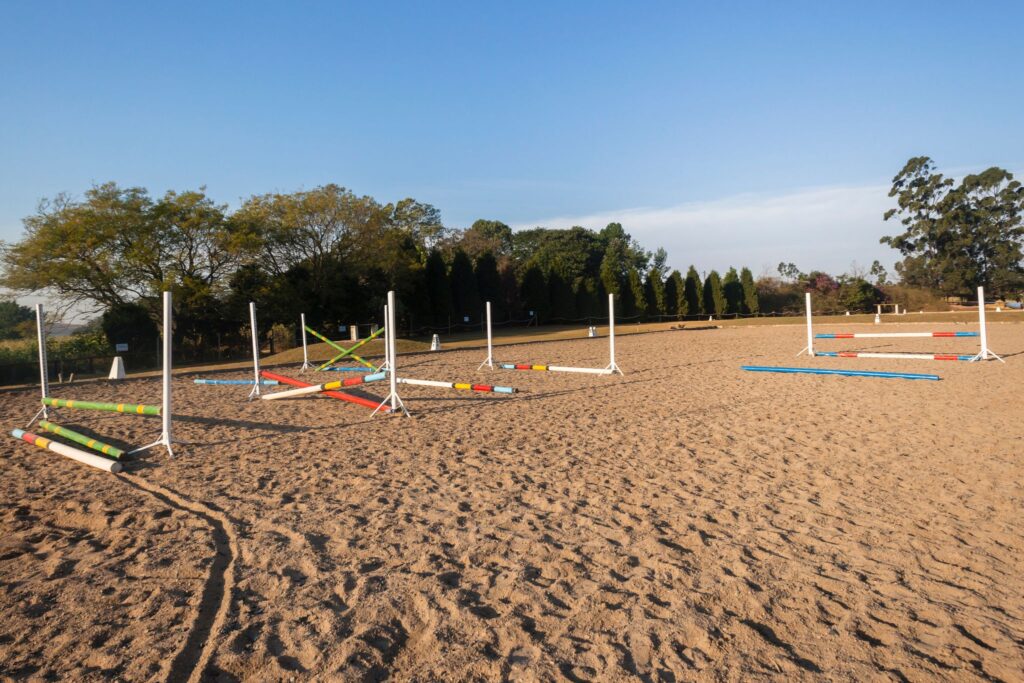
Source: Canva
Riders should be jumping a level higher at home than they jump in competition.
Sharp Turns
The course walk is the perfect time to examine where tighter turns may be possible in order to save time in the jump-off. Often, course designers put islands of decorative material in the arena, marking where riders can opt for a shorter route—an “inside option.”
Inside options can save time, taking a shorter track between two fences
Rollbacks
A rollback turn is very commonly used in both Jumper and Equitation classes.
Bending Lines
You will see varieties of bending, or curved lines, from lower-level competition all the way through top-level competition.
A soft bending line—or two jumps placed with a gentle curve between them—can usually be ridden on three different paths:
- A direct path or almost straight line between them
- A line that travels smoothly from the center of the first to the center of the next
- A wider path with typically one or two strides more between the jumps
A tighter bending line has a much sharper turn between the jumps and is more commonly ridden as two separate jumps with a turn between them—as opposed to a related distance.
In both types of bending lines, the configuration of the jumps is paramount to determining the best strategy.
If a wide square oxer or triple bar is the first jump in the line, the horse will likely give a larger, higher jumping effort, therefore covering less ground upon landing.
In this scenario, the rider might decide to do one more collected stride, especially if the next jump in the line is fragile, such as a skinny or an airy vertical.
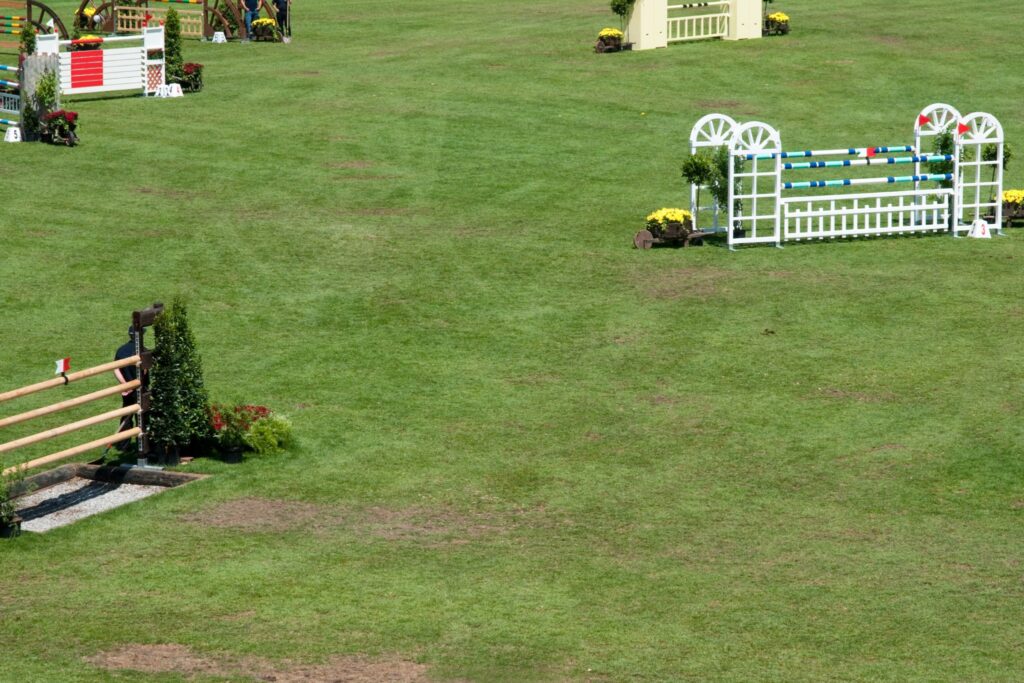
Source: Canva
An important thing to understand when walking distances, especially in a bending line, is that there are options. A shorter-strided horse will probably be more comfortable doing more strides than one with a huge stride.
Discuss the best option for your horse with a veteran rider or trainer and have confidence in your plan!
Counting Strides
In order to walk a course correctly, you must be able to count strides and translate them into human steps. A horse’s stride is twelve feet. Obviously, we as humans cannot take a twelve foot step! But, you can break it down into four big steps.
Before you set foot into the competition ring, practice your “stride steps” so that they consistently reach 3 feet. This will give you the most accurate course walk when you are at the show.
It is also important to note that when a horse lands in a jump line it subtracts 6 feet, and when a horse takes off in a line, it also subtracts another 6 feet. I know I didn’t get into riding horses because I just *really* loved math… but here we are.
Learning to count strides is part of the package.
How do you count your strides when walking a course?
Now that you’ve practiced your big stride steps and got your math memorized, you are ready to start counting strides when on a course. Since four of your big steps equals one horse stride, you need a method of keeping track.
My favorite is “1-2-3-4-, TWO-2-3-4, THREE-2-3-4” etc. This helps me keep track of what stride number I’m on.
How do you walk a jump line?
A jump line is two jumps that are jumped back to back on a straight or bending line.
Counting these strides correctly is imperative for a successful round. When going to walk your line, you start with your heels directly at the base of the jump. Then you start your steps!
There are a few (at least!) schools of thought when walking a line on how to count:
School One
With your heels at the base of the jump, just start walking and counting your big steps all the way to the base of the next jump.
Then subtract an entire stride from your total. Since a landing stride is six feet, and a landing stride is six feet—that equals one full horse stride.
School Two
With your heels at the base of the jump, take two big steps. This is your landing stride. Zero out your counts (i.e. start back at ONE-two-three-four) count to the base of the next jump.
If you do it correctly, you would be two strides over a round number. Those extra two strides would account for the take off stride.
School Three
Bethany Lee takes a mix of both of the above methods to create a “zero” stride! Her video tutorial is great for visual learners.
Note: All of this is based on a horse’s stride. If you are riding a pony, they have their own specific stride lengths, which will change how you walk a line.
How do you set up a bounce jump?
After you understand the stride length and how that affects the space between jumps, it is relatively easy to set up a bounce jump for training at home.
Though you won’t see a bounce jump in mainstream competitions, bounce jumps are great for teaching a horse to rock back and engage their hind end.
It also builds core and leg strength for the rider. Since a bounce jump has no stride between the two jumps, you only have to factor in landing and take off, i.e. twelve feet.
Course Layout
Now that you know how to count your strides on the ground, it is time to think about the big picture—the full course!
Course layout depends on the discipline, but the key components like combinations, rollbacks, and the need to memorize all of it in a short amount of time is universal.
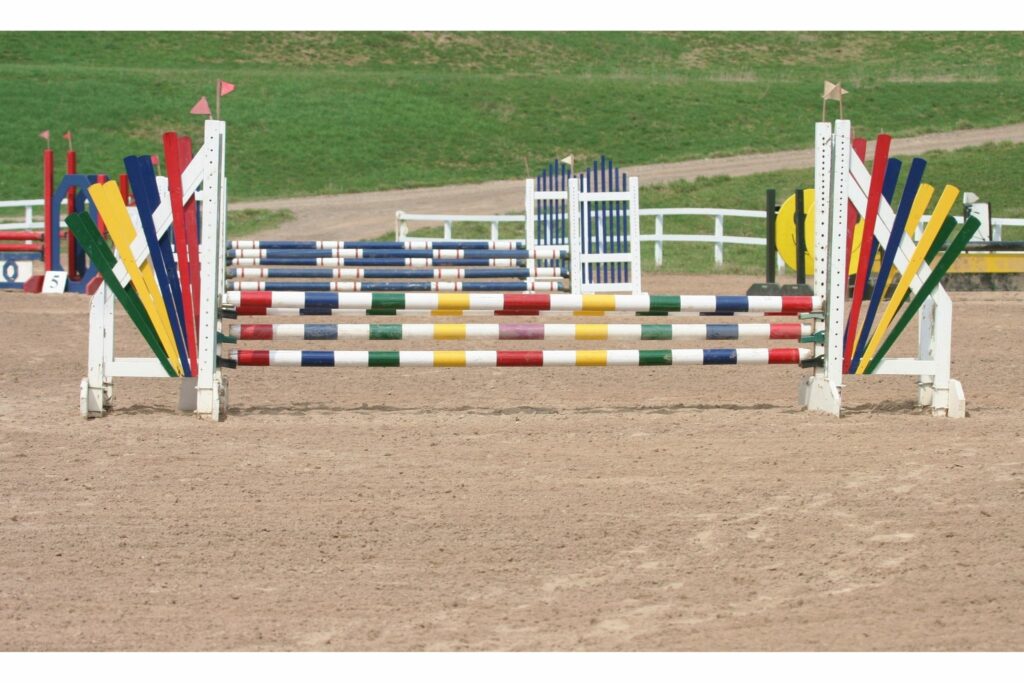
Photo Cred: Canva
How do you memorize a showjumping course?
Remember all that pointing I was talking about earlier? I believe that helps in the memorization of a course because it allows you to draw out the course in the air.
Here are a few other ways to ensure you keep those jumps in order in your brain!
Break the course into sections
This helps with longer courses, or if you are jumping the same jump in two different directions. When you break the course into smaller sections, it allows you to memorize chunk by chunk and your brain is able to compartmentalize each section.
Here’s an example: “I’m doing the outside line to diagonal line first” that’s my first chunk, then I’ll turn around the tree to my next section, the bending line to single oxer.
After that, I’ll finish my course with the outside line and single diagonal.” Then you go back and memorize.
Name the Jumps
All the jumps are going to have some kind of identifying feature—pink flowers, blue standards, etc. When you name the jumps, it helps you identify them on course and in your brain!
Speaking it aloud helps, especially with the named jumps. If you have a friend or barn-mate in the same ring with the same course, work on this together.
Draw it Out
Your course will be posted as a birds eye view, take a photo and then go into “edit” on your phone.
You can then draw out the course on your phone. This lets you visualize your course.
How many jumps are in a showjumping course?
A
Fun fact: The 2020 Olympic
show jumping had a maximum allowed 17 jumping obstacles!
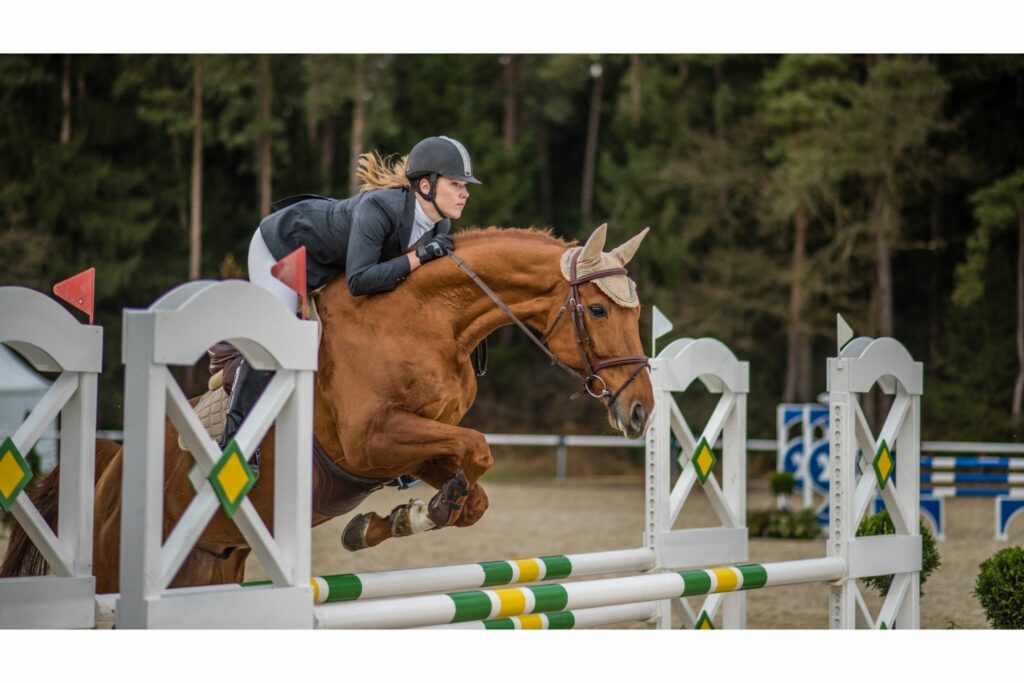
Photo Cred: Canva
Mental Preparation
As in any competitive sport, riding has a huge mental component. In this lesson, we’ll discuss ways to help maintain your mental edge at a show.
Control What You Can Control
In riding there are two thinking beings to consider—the rider and the horse. As the rider, you have a responsibility to prepare yourself for the competitive environment. You then need to consider what might be going through your horse’s mind. We’ll tackle both.
The rider’s mental preparation starts with organization. It is your job to have equipment clean and ready. A last-minute search for one spur that makes you late to your warmup isn’t fair to your teammate—your horse.
Need help connecting with your teammate? The Partnership Puzzle will strengthen your bond.
The next step in mental preparation is arriving at the show early to allow enough time to learn your course thoroughly. It is not enough to know the order of the jumps. You should have a more comprehensive plan in place. Allow enough time to memorize that plan.
Memorization includes visualizing yourself going around the course and being able to picture the details of the course in your mind without needing to stand ringside.
In other words, you must be able to picture the details of the entire course without looking at the ring. This level of mastery—committing the course completely to memory—increases the chances that you will be able to maintain focus in real-time.
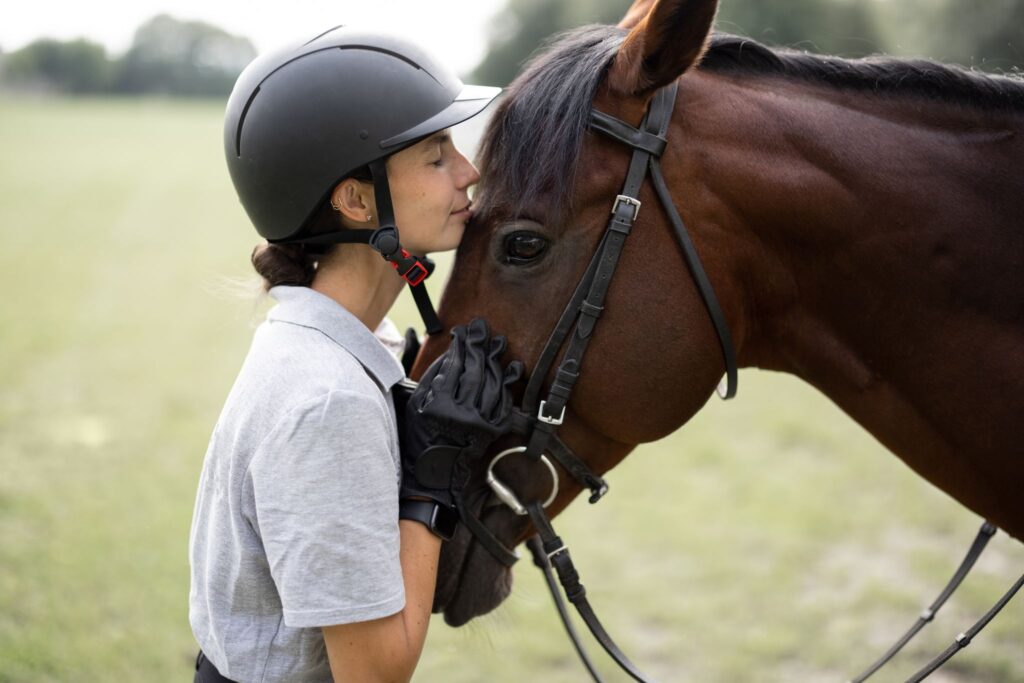
Source: Canva
If you have the luxury of knowing your horse really well, you will be able to anticipate what your horse might feel while on course, including areas where the horse might become spooky, nervous or excited.
There is no single approach to mental preparedness for horse or rider. Everyone experiences the excitement of competition differently, but knowing what works for you is important for your overall success.
Frequently Asked Questions
Q: What is a horse stride chart?
A horse stride chart is a handy way to check the average stride length for horses. (Note: Pones have shorter strides than horses, as they are not as tall.) Since I am primarily a hunter rider, the one I most often reference can be found on the USEF website, here.
Q: Where can I find a showjumping distance table?
A quick reference guide for stride length and distance can be found on any
Parting Thoughts
Now that you know how to measure your distances and walk your lines, you’re going to be even more prepared for your next show. But, the best way to prepare is to practice at home! If you want to set up a jump course to practice in your own arena, we recommend you check out our article here. Remember—stay on course, and trust your horse!
P.S. Enjoy this article? Trot on over to:
- 10 Best Stirrups for Jumping Clear (And Staying Safe)
- Jump Jargon: A Simple Guide to Horse Jumping Terms
- Compositi Stirrups Review: I’ve Never Jumped Better
- 100+ Things to Pack for a Jumping Horse Show (Checklist)
- When can (and should) you start jumping a horse?
- 4-Star Favorites: The 4 Best Cross Country Stirrups
- Horse Riding for Older Adults: Why It’s Never Too Late
- How Often to Replace Horseback Riding Helmets
Sources
Susan Tinder’s Jump Course Design Manual
https://www.readysupp.com/blog/tag/jumping-distances/
https://files.usef.org/assets/7HRXSEWa4ps/2016-usef-hunter-cd-online.pdf

